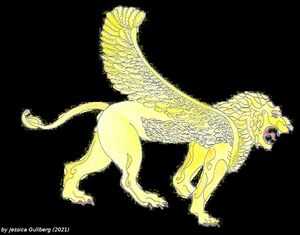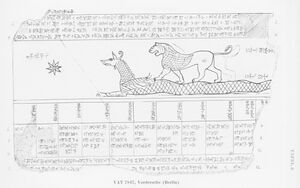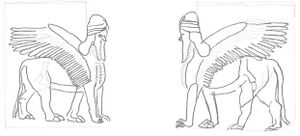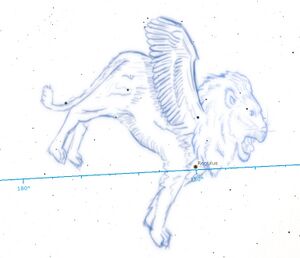UR.GU.LA
A Mesopotamian constellation that is usually identified with Leo, The Lion.
[Waerden 1949, 13; 1952-53 219; 1974, 70; Weidner 1957-59, 74b; BPO 2, 16; MA, 137; Mesop.Astrol., 207, App. C; ASM, 273; Horowitz 2014, 249; Beaulieu et al. 2018, 76].
URGULA in Dictionaries of Babylonian Astral-Science
Kurtik with Hoffmann, Horowitz and Kim
= mulurgullû “Lion”; constellation, corresponding to contemporary Lion (Leo) [G. 162; AHw, 1429a; BPO 2, 16],
see also.
| Sources by Kurtik and Horowitz | Identification by Hoffmann and Horowitz |
|---|---|
Lexical texts.
|
|
| “Prayers to night gods.”
Neo-Assyrian prayer: amidst the astral gods is also mentioned mulUR.GU.LA [Oppenheim 1959, 283:17]. |
|
| Enuma Anu Enlil (ЕАЕ).
См. [BPO 2, XV 14, XVI 15, XIX 4; BPO 3, 289; NSAM 2, 249; SpTU III, 101 r. 14–15; Stev. O.T 232:9–11, Pl. XVII 11–13]. |
|
“Astrolabes”.
|
|
| “Catalog of 30 stars”.
Anu 7. [mulUR.GU.LA ša2 EGI]R.BI GUB-zu dLa-ta-ra-a[k…] “[The Lion, which] stands [aft]er it, the Latara[k…]” (B. 22) [Oelsner–Horowitz 1997–98, 178]. |
|
MUL.APIN.
|
|
| “Letters and Reports”. See. [LABS, 381; ARAK, 352]. | |
“The Great star List”.
|
|
List of ziqpu-stars.
in mulUR.GU.LA,
|
|
| List “4-x of Enlil”.
see. (e10) dEn-lil2. |
|
| GU-text. (E), (G), (H), (I), (J),
see. (a18) AL.LUL, (u17) UR.A. |
same as in MUL.APIN  The GU-text dates half a millennium later and the name of the constellation is abbreviated. We are not sure that the creature is still considerd with the wing or a simple, normal Lion (as the constellation is depicted on the circular Dendera-zodiac) but as it has been a Babylonian/ Assyrian gate keeper before and after, this interpretation is still likely. |
Dalbanna-text.
|
there is a note in the edition by Hunger and Pingree (1999) that one of the Lions mentioned here may possibly be female.
This interpretation is changed in Horowitz and Hoffmann (2024). |
Text Nv. 10.
(Obv. 1'–4') [Donbaz–Koch 1995, 64–65, 69]; according to [ibid., 79, Anm. 63], mulṢal-bat-a-nu — planetary name for mulmuš, “Serpent (main star — α Hya). |
|
| Astronomical Diaries and Related Text (ADRT).
Within the constellation, 5 "normal stars" are distinguished, see below, as well as (Kurtik m39) MUL2.ŠID.MEŠ. |
|
Late astrology.
|
|
| Parts of the constellation and individual stars
(1) SAG A “Head of the Lion” (ε Leonis). (2) LUGAL “King” (α Leonis). (3) MUL2 TUR ša2 4 KUŠ3 ar2 LUGAL “Small star four cubits behind the King” (ρ Leonis). (4) GIŠ.KUN A “The hip of the Lion” (θ Leonis). (5) GIR3 ar2 ša2 A “Hind paw of the Lion” (β Virginis); GIR3 ša2 UR.<A> “Lion’s paw” в [ADRT I, 70, No.-384: 9′]. Stars (1)–(5) used as “normal stars” within diaries and other observational texts, see. (Kurtik m39) MUL2.ŠID.MEŠ, no. 17–21. (6) 2 stars on the head of the Lion (= ziqpu XXI: μ , ε Leo). (7) Front right paw of the Lion, see. (Kurtik u17) UR.A, GU-текст (G). (8) Paw in the central portion of the Lion (ρ Leo), see. (Kurtik u17) UR.A, GU-text (H) (9) 2 stars on the Lion’s hip (= ziqpu XXIII: δ, θ Leo). (10) Individual star on the Lion’s tail (= ziqpu XXIV: β Leo). (11) “Upper (star) Lion” or “Upper from the star on the head of the Lion” (μ Leo), см. dbn-текст (§ N). (12) “Lower (star) Lion” or “Lower from the star on the head of the Lion” (ε Leo), see. dbn-text (§ О). (13) Lion’s Beard (λ Leo), see. dbn-text (§ О). (14) KA2 mulxUR.A “Lion’s gate” [NSAM 2, 38, Text Ii:4]. |
Further mentions of the term
II. Deity.
Latarak (see Kurtik L05).
Prayers and rituals. (1) Namburbi series, cf. [Ebeling 1954, 12-13:7]. In astrological geography, Leo is correlated with a number of cities and temples, including: (a) c Enamhe, (b) Isin, Egalmah, (c) Eridu, (d) Kulaba, etc. [Weidner 1963].
III. Symbol.
The Walking Lion. The image of a lion (upon which is the inscription: mulUR.GU.LA) strolling on the serpent-dragon's back mulMUŠ see on the Seleucid tablet VAT 7847 [Weidner 1927, Taf. V. 2; 1967, Taf. 5-6; Kurtik 2007, fig. 11]. For a description of this scene see thefragmentary text: [MUL] dUR.GU.LA ṣa-mi-du / [...] MUL dMUŠ ka-bi-is, quoted in [Wiggermann 1997, 34, note 13]. See also the astral images of the Lion on Hellenistic Uruk seals [AUWE 19, no. 783-785, 811, 813, 814, 816, 819, 820; Kurtik 2007, figures 28, 29, 30]. According to [Foxvog 1993, 107], text W 22646 contains a list of symbols of zodiacal constellations in which the month Abu (itiNE) is associated with the Lion (múlUR), corresponding to UR.MAḪ "lion" [SpTU II, 43:5, 22].
VI. Astrology.
Identifications:
(1) = mulUR.MAḪ "Lion"; see (Kurtik ts02)dṢalbatānu, III 38.
(2) = mulRappu "bridle"; see (Kurtik r03)Rappu, II 2.
(3) = mulEturammi "Star of Eturammi," see Lexical Texts, “The Great Star lists”, and also (Kurtik e06)E2.TUR3.
(4) = Wolf Star = Mars; [m]ulUR.GU.LA = mulUR.BAR.RA = dṢal-bat-a-nu "Lion = Wolf = Mars" [SpTU I, 50:37].
Predictions:
(5) If the Lion is black, Mercury stands in Leo; mulGUD.UD ina ŠA3 mulUR.GU.LA it-ti-ti-zi / DIŠ mulUR.GU.LA GI6 / ŠA3-bi KUR NU DUG3.GA / DIŠ mulLUGAL GI6 / mu-ʼi-ir-ru E2.GAL UŠ2 "Mercury stands within Leo. If the Lion is black: the hearts of people in the country will not be happy. If Regulus is black: the governor of the palace will die." [ARAK, 146:1-6], see also [ibid., 180:3-4]; DIŠ mulUR.GU.LA MI (var.: ma-diš MI) ŠA3 KUR NU DUG3-ab "If the Lion is dark (var.: very dark): the heart of the country will not be happy". [BPO 2, XV 14, XVI 15 + Parallels, XIX 4; ARAK, 180 r. 3; 337:3].
(6) If the Lion is black, the first morning appearances of Saturn is in Leo; DIŠ mulUR.GU.LA a-dir / 3 MU.MEŠ [UR].MAḪ.MEŠ / u UR.BAR.R[A.ME]Š LU2.U18.LU GAZ A.RA2 KUR [MAR.T]U KUD. MEŠ "If the Lion is dark: within 3 years, [li]ons and wol[ves] will kill off people and cut short lines of communication with [Weste]rn portions of the country." [ARAK, 324:3-6; 437:6-r. 2].
(7) The moon eclipses within the regions of the Leo; [...mulUR.GU.L]A ˹a-dir˺ EŠ.BAR LUGAL UŠ2-ma UR.A.MEŠ IDIM. MEŠ "(If the Moon) eclipses [in the region of) the [Leo]: a decision for the king, (the king) will die and the lions will become fierce" [NSAM 2, 54, Text IIa: 2′], see also [Weidner 1963, 118, MNB 1849 r. 45].
(8) If the stars of Leo flare (the first morning appearance of Jupiter in Leo); see u22UR.MAḪ, IV 3.
(9) Jupiter's retracting motion moving away from the chest of the Lion (i.e., from Regulus); "And as for Jupiter, the following can be said of it: If it comes back right away from the chest of the Lion (šum-ma TA ŠA3 GABA ša2 mulUR.GU.LA / a-na qi2-in-niš is-si-ḫur): it is a sinister (sign)". [LABS, 8 r. 12-14].
(10) Venus stands in Leo; DIŠ ulDil-bat ina ŠA3 ulUR.GU.LA GUB-iz ME3 (GAL) GAL2 "If Venus stands within Leo: (a great) battle will occur". [Stev. O.T 232:9, Pl. XVII 11], see also [BPO 3, 104, K.3632:21; 217, K.3601+: r. 14].
(11) Venus stands in the eastern portion of the Leo; DIŠ ulDil-bat ina dUTU.E3 ina ŠA3 ulUR.GU.LA GUB ina KUR NIM.MA(ki) ME3 GAL2 "If Venus stands in the inner and eastern portion of the Leo: a (great) battle will occur in Elam". [Stev. O.T., 232:10, Pl. XVII 12], see also [BPO 3, 104, K.3632:22; 217, K.3601+: r. 15; SpTU III, 101 r. 14].
(12) Venus stands in the western portion of the Leo; DIŠ ulDil-bat ina dUTU.ŠU2.A MIN (= ina ŠA3 ulUR.GU.LA GUB) ina KUR URIki ME3 GAL2 "If Venus stands in the inner and western portion of the Leo: a (great) battle will occur in Akkad [Stev. O.T., 232:11, Pl. XVII 13], see also [BPO 3, 104, K.3632:23; 217, K.3601+: r. 16; SpTU III, 101 r. 15].
(13) Venus reaches Leo, its "secret place"; see (Kurtik d06)Dilbat, Late Astrology, Hipsoma (a).
(14) The Wolf Star (= Mars) reaches Leo; see u18UR.BAR.RA, IV 7.
(15) Mars standing in Leo; ts02Ṣalbatānu, III 38.
(16) Mars' retracting motion moving away from the head of the Leo; (Kurtik ts02) Ṣalbatānu, III 38.
(17) Leo (= Mars) rises towards Zababa; [DIŠ mulU]R.GU.LA ana A2 dZa-ba4-ba4 iš-qu A.KAL.MEŠ KUD.MEŠ [...] "[If the L]ion rises towards Zababa: flooding will cease? [...]" [ACh Ištar, 34:15].
(18) Predicting the first morning appearance of Venus in Leo; ina ŠA3 ITI a-ga-a ina dUTU.E3 / ina ŠA3 mulUR.GU.LA in-nam-mar "During this month (Venus) will become visible in the east end of Leo" [ARAK, 247 r. 2-3].
Historical Dictionaries
| Kurtik (2022) | Gössmann (1950) |
|---|---|
| = mulurgullû «Лев»; созвездие, соответствующее современному Льву (Leo) [G. 162; AHw, 1429a; BPO 2, 16], см. также a01A, u16UR, u17UR.A, u22UR.MAḪ.
I. Источники. Лексич. тексты. (1) Серия Urra XXII: mulur.gu.la = la-ta-rak «Лев = Латарак» [Cavigneaux 1981, 105, 79.B.1 / 5 iv 10; Bloch–Horowitz 2015, 107:287ʹ], [mule-tu-r]a?-am-me = mulur.gu.la «[Этур]амме? = Лев» [Cavigneaux 1979, 134, 17:20]. (2) Серия AN:dAnum (VI 118): dur.gu.la = kat-til-lu «Лев = хищный зверь» [Litke 1998, 209; AHw 466a]. «Молитвы ночным богам». Новоассирийская молитва: среди астральных богов упоминается также mulUR.GU.LA [Oppenheim 1959, 283:17]. ЕАЕ. См. [BPO 2, XV 14, XVI 15, XIX 4; BPO 3, 289; NSAM 2, 249; SpTU III, 101 r. 14–15; Stev. O.T 232:9–11, Pl. XVII 11–13]. «Астролябии». Astrolabe P. Месяц симану, звезды Ану, 120 [Pinches 1900, 574]. Astrolabe B. (1) Список (12´3): ˹mul˺ ša ina igi-it m[ul… gub-z]u / [mulur.gu.la…] «Созвездие, которое [стоит] впереди … [это Лев…]» (B ii 18–19); параллель см. [Oelsner–Horowitz 1997–98, Anu 7]. (2) Список (3´12): itisig4 … mulur.gu.la šu-ut dA-nim «Месяц симану: … Лев (на пути) Ану (восходит)» (C ii 3). (3) Список (восход–заход=6m): восход — симану, заход — кислиму [KAV 218, C 17, 30; Horowitz 2014, 38, 40], см. s22SIPA.ZI.AN.NA. BM 82923. Месяц симану, звезды Ану: mu[lUR.GU.LA // 2] // GU.LA GAL-u2 «[Лев // 120] // Большой …» [Walker–Hunger 1977, 30:8, 32 note 8]. BM 34713. См. k10KAK.SI.SA2. «Круглые астролябии». K.14943+: itiab.ba.e3 // mulur.gu.la // 2,20 «(Звезды Эа), месяц тебету, Лев, 140» [CT 33, 12]. Звезды Эа, Ану и Энлиля. a) Список 12 звезд Энлиля (№ 8): mulur.gu.[la] [CT 33, 9 r. 4; MCG, 176]. b) Список 12 звезд Ану (№ 3): mul˹ur.gu˺.la [TCL 6, 13; Rochberg-Halton 1987b, 212]. «Каталог 30 звезд». Anu 7. [mulUR.GU.LA ša2 EGI]R.BI GUB-zu dLa-ta-ra-a[k…] «[Лев, который] стоит [пос]ле него, Латара[к…]» (B. 22) [Oelsner–Horowitz 1997–98, 178]. MUL.APIN. (1) Звезды Энлиля (№ 8, 9, 10): a) mulUR.GU.LA dLa-ta-ra-ak «Лев, Латарак» (I i 8), b) MUL ša2 ina GABA mulUR.GU.LA GUB-zu mulLUGAL «Звезда, которая стоит на груди Льва, Царь» (I i 9), c) MULmeš um-mu-lu-tum ša2 ina KUN mulUR.GU.LA GUB-zu «Тусклые звезды, которые стоят на хвосте Льва» (I i 10–11)]. (2) Даты гелиакических восходов: «15-го дуузу Стрела, Змея и Лев восходят» (I ii 42), см. k10KAK.SI.SA2. (3) Одновременные суточные восходы и заходы: а) «Стрела, Змея и Лев восходят, Великан и Орел заходят» (I iii 17–18), см. a04A2mušen, b) «Поле, Великан и Олень восходят, Лев, Змея и Энтенабархум заходят» (I iii 31–32), см. a48AŠ.GAN2. (4) Список ziqpu-звезд: mulUR.GU.LA после mulAL.LUL «Краб» перед mulE4-ru6 «Эруа» (I iv 6). (5) Кульминации и одновременные гелиакические восходы: Лев кульминирует, Весы восходят (I iv 25), см. z10Zibānītum, см. также [Horowitz 1989–90, 117, BM 73815: 4′]. (6) Звезды «на пути Луны»: mulUR.GU.LA, после mulAL.LUL, перед mulAB.SIN2 (I iv 34), см. s20Sîn. (7) Первая интеркаляционная схема: SAG.DU mulUR.GU.LA «Голова Льва» (II i 11, 17) [MA, 20, 21, 41, 48, 52, 59, 65, 68, 72, 75]. «Письма» и «Рапорты». См. [LABS, 381; ARAK, 352]. «Большой список звезд». (1) mulra-ap-pu = mulur.gu.la «Узда = Лев», mule-tu!-ram-mi = mulmin «Этурамми = Лев», mul sag ur.gi7 = mulmin «Голова Пса = Лев». (2) 12 звезд Элама: [mulur.gu.la] [Mesop.Astrol., App. B:136–138, 202]; см. также список «7 tikpi-звезд» [KAR, 142 i 36]. Списки ziqpu-звезд. См. s06SAG.DU mulUR.GU.LA, g03(MUL) 4 ša2 GABA-šu2, g23MUL 2 ša2 GIŠ.KUN-šu2, d08MUL DILI ša2 KUN-šu2. Список «4-х Энлилей». См. e10dEn-lil2. GU-текст. (E), (G), (H), (I), (J), см. a18AL.LUL, u17UR.A. Dalbanna-текст. §N. [mul] x ur.gu.la an.t[a] «Верхняя [звезда] Льва (μ Leo); = [mul]˹sag˺ ur.gu.la an.t[a] «Верхн[яя] из [звезд] головы Льва», согласно [Koch 1995, 46, 58]. §O. a) [mul…] ur.gu.la ki.ta-tum «Нижняя [звезда …] Льва» (ε Leo); = [mul]˹sag˺? ur.gu.la ki.ta-tum «Нижняя (звезда) головы Льва», согласно [Koch 1995, 46, 58], b) [mul s]u6? ur.g[u.la] «[боро]да Ль[ва]»(λ Leo), с) […giš.kun ur.gu.la]? «[…бедро Льва]» (θ Leo), см. m18MAŠ.TAB.BA.TUR.TUR. §Q. […ur]gu.la ḫe-pi2 ˹3 mul˺.[meš …] 2 dal.ba.an.na min «[…], [Л]ев, повреждение: 3 зве[зды …]. 2 интервала, ditto» [Walker 1995, 33; ASM, 106–107; Koch 1995, 46, 59]. Текст Nv. 10. [ina itiapin ki.min mulu]˹r.gu.la˺ // 4 šu-ut ˹d˺[En-lil2] / […mulṣal-bat]-a-nu // 3 šu-ut dA-[nim] / […mulNin-maḫ] // 2 šu-ut dE2-[a] / […mul]˹AN.TA˺.GUB.BA // 1 šu-qa2 sim.[maḫ] «[В месяце арахсамну соответственно Л]ев, 4, (звезда на пути) [Энлиля], / [… Ма]рс, 3, (звезда на пути) А[ну], / [… Нинмах], 2, (звезда на пути) Э[а], / [… (от)] Наверху стоящей звезды 1 (до) высоты Ласто[чки]» (Obv. 1'–4') [Donbaz–Koch 1995, 64–65, 69]; согласно [ibid., 79, Anm. 63], mulṢal-bat-a-nu — планетное имя для mulmuš «Змея (главная звезда — α Hya). «Дневники наблюдений». В пределах созвездия выделялось 5 «нормальных звезд», см. ниже, а также m39MUL2.ŠID.MEŠ. Поздняя астрология. (1) «Гипсома». Созвездие Лев считалось гипсомой, т.е. местом, где действие планеты достигает максимума: a) Венеры, см. d06Dilbat. b) Юпитера, см. s09SAG.ME.GAR. (2) Предсказание цен на злаки по наблюдениям положений планет относительно зодиакальных созвездий и другим явлениям: múlUR.GU.LA [SpTU I, 94:31]. (3) Предсказания лунных затмений по кульминациям звезд и положениям Солнца относительно созвездий. ki-i múlUR.GU.LA a-na ziq-pi izzazu(GUB)zu-ma […] / múlUR.A múl dMUŠ […] / a-di-i dŠamaš múlUR.A ikaššad(KUR-ad2) pi-šer3-ša2 attalû(AN.GI6) u[l …] «Если Лев кульминирует […] / Лев, Змея […] / До тех пор пока Солнце достигает Льва. Его значение: затмения н[е (будет)]» (W 22554/2) [SpTU III, 102:9–11]. (4) Предсказания, основанные на наблюдениях затмений Луны и положений Луны и планет относительно знаков зодиака. DIŠ Sin ina mulUR.G[U.LA AN.MI GAR-ma]… «Если Луна [затмилась] во Ль[ве]…» [Rochberg-Halton 1984, 134:5′ + passim], см. s20Sîn. См. также [DIŠ K]I MUL 2 MUL2 ša2 SAG.DU mulUR.GU.LA «[Если в обла]сти 2 звезд головы Льва (он родился)», DIŠ KI MUL 4 ša2 GABA-šu2 «Если в области 4 звезд его (= Льва) груди (он родился)», DIŠ KI MUL 2 ša2 GIŠ.KUN-šu2 «Если в области 2 звезд на его (= Льва) крестце (он родился)», [DIŠ K]I mule-du ša2 KUN-šu2 «[Если в обла]сти Отдельной звезды на его (= Льва) хвосте (он родился)» [SpTU V, 265: 4'–7']. См. также [SpTU I, 97:3; SpTU V, 270:1]. II. Божество. Латарак (см. L05). Молитвы и ритуалы. (1) Серия Намбурби, см. [Ebeling 1954, 12–13:7]. В астрологической географии Лев соотносится с рядом городов и храмов, в том числе: a) c Энамхе, b) Исином, Эгальмахом, c) Эриду, d) Кулабой и др. [Weidner 1963]. III. Символ. Идущий Лев. Изображение Льва (над которым надпись: mulUR.GU.LA), идущего по спине змеиного дракона mulMUŠ, см. на селевкидской табличке VAT 7847 [Weidner 1927, Taf. V. 2; 1967, Taf. 5–6; Куртик 2007, рис. 11]. Описание этой сцены см. в фрагментарном тексте: [MUL] dUR.GU.LA ṣa-mi-du / […] MUL dMUŠ ka-bi-is, цит. по [Wiggermann 1997, 34, note 13]. См. также астральные изображения Льва на печатях из эллинистического Урука [AUWE 19, No. 783–785, 811, 813, 814, 816, 819, 820; Куртик 2007, рис. 28, 29, 30]. Согласно [Foxvog 1993, 107], текст W 22646 содержит список символов зодиакальных созвездий, в нем месяцу абу (itiNE), связанному со Львом (múlUR), соответствует UR.MAḪ «лев» [SpTU II, 43:5, 22]. IV. Отождествление. = Leo [Waerden 1949, 13; 1952–53 219; 1974, 70; Weidner 1957–59, 74b; BPO 2, 16; MA, 137; Mesop.Astrol., 207, App. C; ASM, 273; Horowitz 2014, 249; Beaulieu et al. 2018, 76]. V. Части созвездия и отдельные звезды. (1) SAG A «Голова Льва» (ε Leonis). (2) LUGAL «Царь» (α Leonis). (3) MUL2 TUR ša2 4 KUŠ3 ar2 LUGAL «Маленькая звезда в 4 локтях позади Царя» (ρ Leonis). (4) GIŠ.KUN A «Бедро Льва» (θ Leonis). (5) GIR3 ar2 ša2 A «Задняя лапа Льва» (β Virginis); GIR3 ša2 UR.<A> «лапа Льва» в [ADRT I, 70, No.-384: 9′]. Звезды (1)–(5) использовались в качестве «нормальных звезд» в дневниках и других текстах наблюдений, см. m39MUL2.ŠID.MEŠ, № 17–21. (6) 2 звезды головы Льва (= ziqpu XXI: μ , ε Leo). (7) Передняя правая лапа Льва, см. u17UR.A, GU-текст (G). (8) Лапа в средней части Льва (ρ Leo), см. u17UR.A, GU-текст (H) (9) 2 звезды на бедре Льва (= ziqpu XXIII: δ, θ Leo). (10) Отдельная звезда на хвосте Льва (= ziqpu XXIV: β Leo). (11) «Верхняя (звезда) Льва» или «Верхняя из звезд головы Льва» (μ Leo), см. dbn-текст (§ N). (12) «Нижняя (звезда) Льва» или «Нижняя из звезд головы Льва» (ε Leo), см. dbn-текст (§ О). (13) Борода Льва (λ Leo), см. dbn-текст (§ О). (14) KA2 mulxUR.A «Ворота Льва» [NSAM 2, 38, Text Ii:4]. VI. Астрология. Отождествления: (1) = mulUR.MAḪ «Лев»; см. ts02dṢalbatānu, III 38. (2) = mulRappu «Узда»; см. r03Rappu, II 2. (3) = mulEturammi «Звезда Этурамми», см. Лексич. тексты, «Большой список звезд», а также e06E2.TUR3. (4) = Волчья звезда = Марс; [m]ulUR.GU.LA = mulUR.BAR.RA = dṢal-bat-a-nu «Лев = Волк = Марс» [SpTU I, 50:37]. Предсказания: (5) Лев черный, Меркурий стоит во Льве; mulGUD.UD ina ŠA3 mulUR.GU.LA it-ti-ti-zi / DIŠ mulUR.GU.LA GI6 / ŠA3-bi KUR NU DUG3.GA / DIŠ mulLUGAL GI6 / mu-ʼi-ir-ru E2.GAL UŠ2 «Меркурий стоял внутри Льва. Если Лев черный: сердце страны не будет счастливо. Если Регул черный: управляющий дворцом умрет» [ARAK, 146:1–6], cм. также [ibid., 180:3–4]; DIŠ mulUR.GU.LA MI (вар.: ma-diš MI) ŠA3 KUR NU DUG3-ab «Если Лев темный (вар.: очень темный): сердце страны не будет счастливо» [BPO 2, XV 14, XVI 15 + Parallels, XIX 4; ARAK, 180 r. 3; 337:3]. (6) Лев черный, первое утреннее появление Сатурна во Льве; DIŠ mulUR.GU.LA a-dir / 3 MU.MEŠ [UR].MAḪ.MEŠ / u UR.BAR.R[A.ME]Š LU2.U18.LU GAZ A.RA2 KUR [MAR.T]U KUD.MEŠ «Если Лев темный: в течение 3 лет [ль]вы и вол[ки] будут убивать людей и перережут пути сообщения с [Запад]ной страной» [ARAK, 324:3–6; 437:6–r. 2]. (7) Луна в области Льва затмилась; […mulUR.GU.L]A ˹a-dir˺ EŠ.BAR LUGAL UŠ2-ma UR.A.MEŠ IDIM.MEŠ «(Если Луна в области) [Льв]а затмилась: решение для царя, (царь) умрет и львы станут свирепыми» [NSAM 2, 54, Text IIa: 2′], см. также [Weidner 1963, 118, MNB 1849 r. 45]. (8) Если звезды Льва вспыхивают (первое утреннее появление Юпитера во Льве); см. u22UR.MAḪ, IV 3. (9) Попятное движение Юпитера от груди Льва (т.е. от Регула); «А что касается Юпитера, можно сказать следующее: Если он возвращается обратно от груди Льва (šum-ma TA ŠA3 GABA ša2 mulUR.GU.LA / a-na qi2-in-niš is-si-ḫur): это зловещий (знак)» [LABS, 8 r. 12–14]. (10) Венера во Льве стоит; DIŠ ulDil-bat ina ŠA3 ulUR.GU.LA GUB-iz ME3 (GAL) GAL2 «Если Венера стоит внутри Льва: (большое) сражение будет» [Stev. O.T 232:9, Pl. XVII 11], см. также [BPO 3, 104, K.3632:21; 217, K.3601+: r. 14]. (11) Венера на востоке во Льве стоит; DIŠ ulDil-bat ina dUTU.E3 ina ŠA3 ulUR.GU.LA GUB ina KUR NIM.MA(ki) ME3 GAL2 «Если Венера стоит на востоке внутри Льва: в Эламе (большое) сражение будет» [Stev. O.T., 232:10, Pl. XVII 12], см. также [BPO 3, 104, K.3632:22; 217, K.3601+: r. 15; SpTU III, 101 r. 14]. (12) Венера на западе во Льве стоит; DIŠ ulDil-bat ina dUTU.ŠU2.A MIN (= ina ŠA3 ulUR.GU.LA GUB) ina KUR URIki ME3 GAL2 «Если Венера стоит на западе внутри Льва: в Аккаде (большое) сражение будет» [Stev. O.T., 232:11, Pl. XVII 13], см. также [BPO 3, 104, K.3632:23; 217, K.3601+: r. 16; SpTU III, 101 r. 15]. (13) Венера достигает Льва, своего “секретного места”; см. d06Dilbat, Поздняя астрология, Гипсома (а). (14) Волчья звезда (= Марс) достигает Льва; см. u18UR.BAR.RA, IV 7. (15) Стояние Марса во Льве; ts02Ṣalbatānu, III 38. (16) Попятное движение Марса от головы Льва; ts02Ṣalbatānu, III 38. (17) Лев (= Марс) в сторону Забабы поднялся; [DIŠ mulU]R.GU.LA ana A2 dZa-ba4-ba4 iš-qu A.KAL.MEŠ KUD.MEŠ […] «[Если Л]ев в сторону Забабы поднялся: наводнения прекратятся? […]» [ACh Ištar, 34:15]. (18) Предсказание первого утреннего появления Венеры во Льве; ina ŠA3 ITI a-ga-a ina dUTU.E3 / ina ŠA3 mulUR.GU.LA in-nam-mar «В течение этого месяца (Венера) станет видна на востоке во Льве» [ARAK, 247 r. 2–3]. |
Transformation from UR.GU.LA to Leo
The templates for the drawings and paintings on our star charts originate from depictions of lions and lion-like daemons that are found in the preserved architecture (e.g. in temple walls, on ceilings, on the wall of the procession street leading towards the Ishtar Gate of the city of Babylon). Here is a gallery of these preserved historical depictions.














